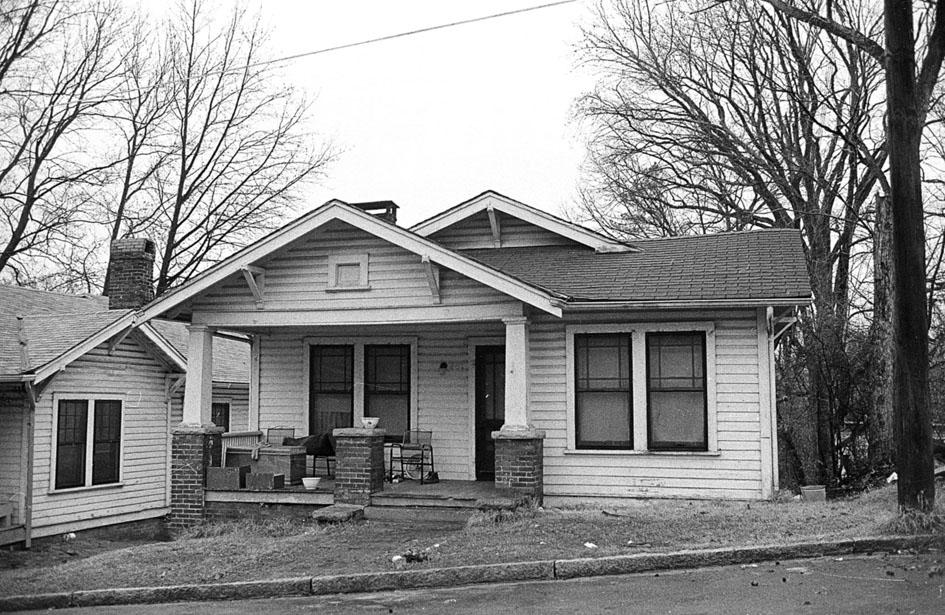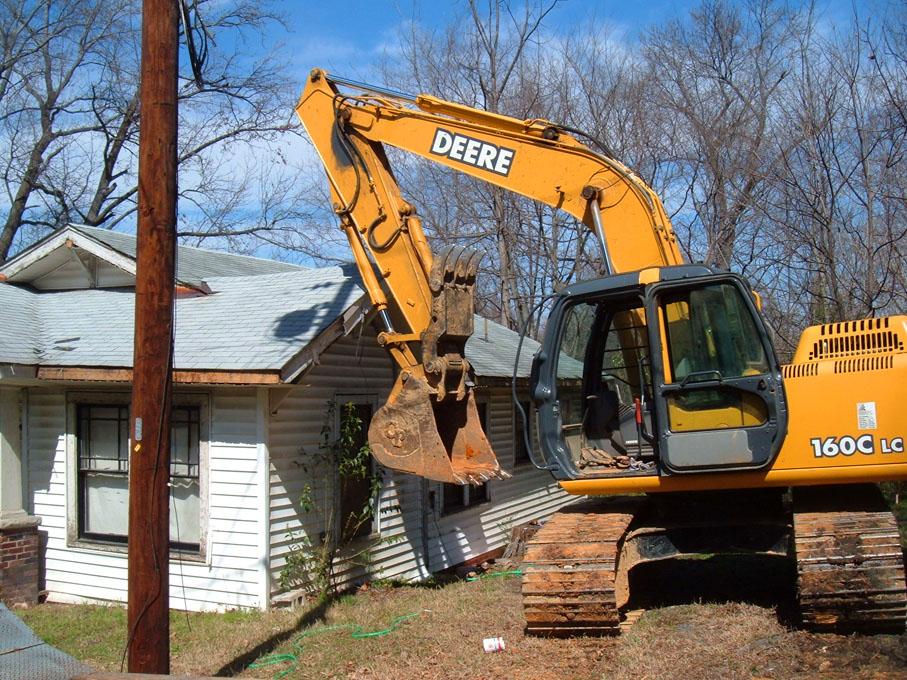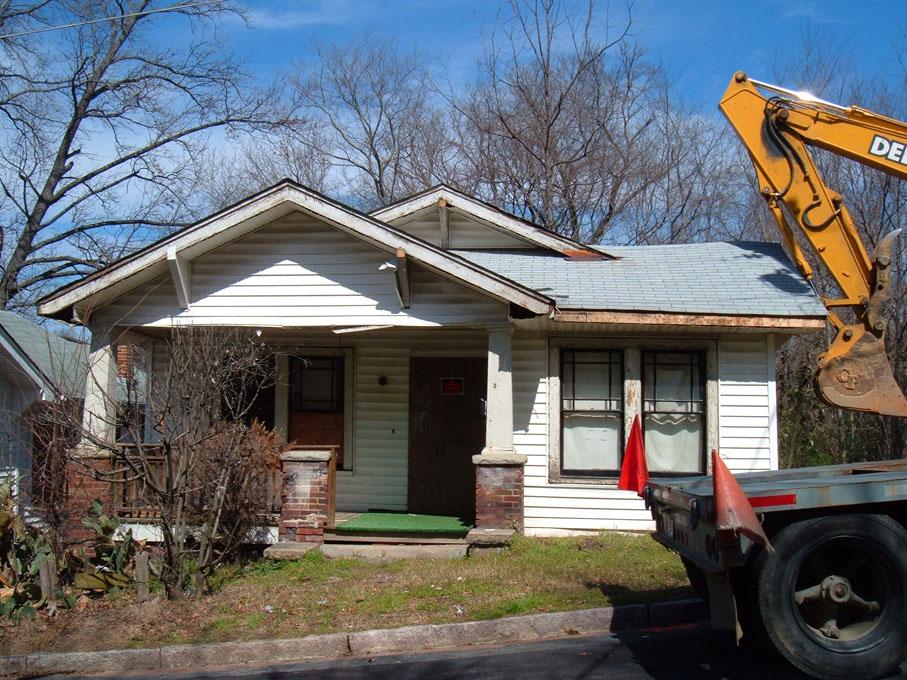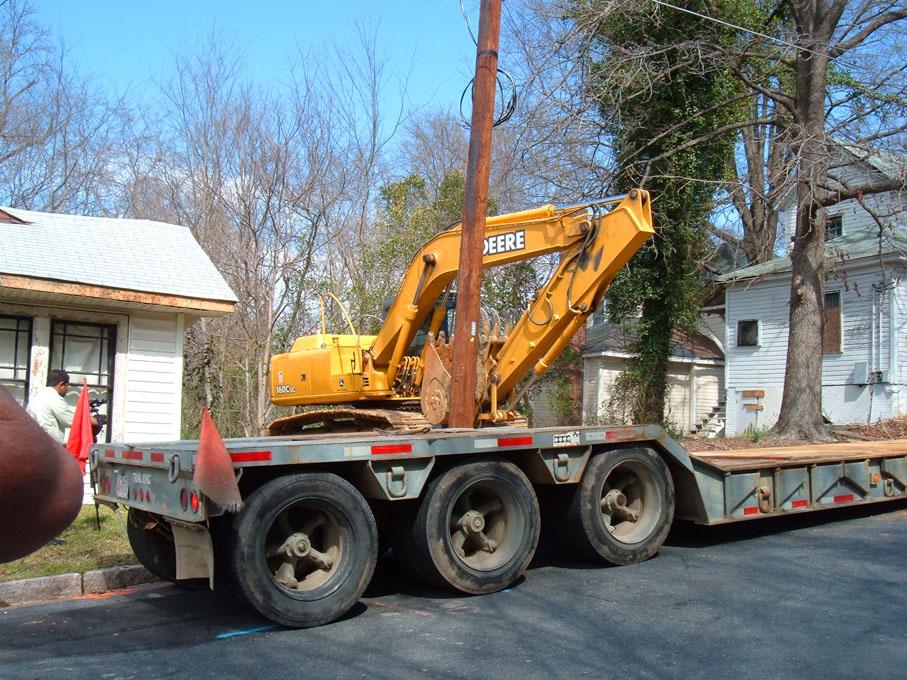A bounce back to the east side of town today for a shout-out to my friends in the Cleveland-Holloway neighborhood who temporarily averted the demolition of a great little Craftsman house is their neighborhood, 407 Ottawa St.
407 Ottawa, 1970s
(Courtesy NC State Historic Preservation Office)
Much of Cleveland-Holloway away from the main streets was developed in the 1920s and 1930s, thus the Craftsman bungalow is a common housing type, with multiple gables, large, unadorned brackets and multi-light windows. Per the National Register listing for this house:
This one-story, cross-gabled Craftsman bungalow is three bays wide and quadruple-pile with a partially engaged front porch. The house rests on a brick foundation, is covered with vinyl siding, and has an asphalt-shingled roof. The soffits and brackets in the front and side gables are also covered with vinyl. Beneath the vinyl, German-profile wood siding, scooped rafter tails, and knee brackets are visible. The house has Craftsman-style nine-over-one windows with a large center pane surrounded by smaller lights. The gabled porch roof is supported by battered posts on brick piers with concrete caps, joined by a replacement rail. The first known resident is Vance O. Isenhour (office manager, Interstate Telegraph & Telephone Company) in 1929.
This fine little example has had a repair-only order placed on it by Neighborhood Improvement Services for housing code violations and began fining the owner. The owner in this case is actually a trustee for an estate. In our housing violation system, an expedient way to make the fines stop is to demolish the house, which is what this trustee opted for.
Only because a neighbor happened to be home from work yesterday was the big yellow piece of equipment noticed before demolition began.
After all matter of pleading and reinforcements and press, the neighbors prevailed upon the demolition company - to the tune of $900 - to go away.
You'll notice in the background of several shots the back of 501 Oakwood, another house that the neighborhood rallied to save from the city bulldozers.
These people care so passionately about the preservation of their neighborhood, they are willing to personally sacrifice to ensure its viability - a viability that is still threatened on all sides. One neighbor has called up the trustee and offered to pay him $10,000 for the house - primarily to prevent it from being torn down. (I'm sure she doesn't really want another house.)
To be clear, these weren't city bulldozers this time. But the city - council- needs to do more to protect the integrity of the historic areas of our city. This portion of Cleveland-Holloway is not yet a local historic district, although they are working hard to become one.
And that's just it - the citizens, all of whom have jobs and lives to live are required to fight tooth and nail to simply keep the neighborhood they have. The onus is on them, rather than the city making proactive efforts to have preservation be a priority. The departments will say "we can't do [whatever]" - and it's true, because the leadership of this city does not promote historic preservation. My understanding is that the mayor's appointee position on the Historic Preservation Commission has sat vacant for - a year? Members of the council want to eliminate property tax reductions for individual local landmarks. The Historic Commission has been disempowered by a city finding that, if NIS deems a property unsafe, demolition permits can be issued without the consent of the HPC.
Why must citizens like those in Cleveland-Holloway swim upstream constantly to save their neighborhoods? Why is the quickest and easiest way for a property owner to deal with fines from code enforcement to proceed with demolition? Why isn't the city leadership their partner, by creating city policy that protects these resources - rather than making the barriers to preservation ever-harder to overcome?
I come back to the city, because they are the only ones who have sufficient power to change this paradigm. Neighbors need more than shrugged shoulders when faced with demolitions that would permanently scar their neighborhood.
Update: This house and its twin neighbor were save, renovated and are happily inhabited.
407 Ottawa, 10.22.10








Comments
Submitted by Stew (not verified) on Wed, 3/12/2008 - 11:32am
Oh, god.
Submitted by nicomachus (not verified) on Wed, 3/12/2008 - 2:19pm
congratulations to the C-H neighborhood.
Submitted by Anonymous (not verified) on Wed, 3/12/2008 - 3:59pm
Great news! The C-H neighborhood -- and that one neighbor -- should be proud. Really an impressive piece of community spirit.
Submitted by Anonymous (not verified) on Wed, 3/12/2008 - 4:22pm
How much do you think the bulldozer guy would charge to take down the trustee's home?
Maybe the trustee could be persuaded to either sell or restore if they had a backhoe breathing down their bedroom wall.
Good for C-H neighborhood in the short term, but large, long term picture doesn't seem promising.
Submitted by Anonymous (not verified) on Wed, 3/12/2008 - 5:38pm
We need a proactive historic preservation planner in Durham. The person in that position now does very little to promote preservation in the city. Why should he, he lives in Raleigh!
Submitted by John Martin (not verified) on Wed, 3/12/2008 - 7:05pm
Surely there can be a simple legislative fix that the city council can enact. Here's my idea: If a property has building code violations and was built before, say, 1940, an owner can escape the fines by signing a binding agreement with Preservation Durham or a similar organization to put the property on the market as one of their "endangered properties." This would give the owner a way to avoid fines and renovation expenses which he may not have resources or time to carry out. Putting the house up for sale would probably bring the property owner more money than he would realize from the lot alone and he would avoid the demolition cost. I can't see that the property owner would lose by such an arrangement. The neighborhood would preserve a house, and insure that it was bought and renovated by a owner who appreciates it.
Is there something I'm not seeing here? Mike Woodard, I know you're lurking out there. Tell me what you think.
Submitted by Anonymous (not verified) on Thu, 3/13/2008 - 2:30am
Amen to the 3rd anonymous comment. The current preservation planner Steve Cruse is ineffective, and needs to be reassigned or retire. He is a place filler and provides no leadership, direction to foster historic preservation in Durham. Steve C., please move on, or Mr. Medlin, find him another job, and hire someone who has the skill sets we need.
Submitted by Boleyn Willis-Zeger (not verified) on Thu, 3/13/2008 - 9:18pm
So what needs to happen to get a new city preservation person in place? I agree very heartily with John Martin's solution. Is his solution viable?
Coming to ya from OND and the "warehouse district"
Boleyn Willis-Zeger
Submitted by Anonymous (not verified) on Sat, 3/15/2008 - 11:15pm
I saw in the paper today that the repairs for this house will cost more than it's tax value ($43,000).
It's real value (what someone is willing to pay for it) appears to be $0.
So is the purpose of this blog to preserve tiny 80 year old houses that nobody wants to buy?
A lot of the commenters seem to think that the city should step in. Thank God for Democracy is all I can say about that, spending tax money on something like 407 Ottawa is like dragging 1980 Buicks out of the junk yard and spending money to put them on the raod again.
Submitted by Gary (not verified) on Sun, 3/16/2008 - 11:43am
Anonymous
I really don't think the market value of houses is set by the city government tax assessor. Since a neighborhood resident in Cleveland-Holloway has offered the trustee $10,000 for this house, that would be the current market value. Of course, you realize that the market value of this house has also been affected by the government spending tax dollars inspecting the house and deeming it in violation of housing code - and subsequently fining the owner. The owner can repair the house or demolish it to stop being fined by the city - which is why this owner has chosen now to demolish the house. Had he refused, the government could have destroyed the house and billed him for the cost of demolition.
At ~$5000 for demolition costs, and using the government-valuation system you've equated with the market, the remaining land is worth $8517. So the government either reduces the land value by $35,000 or fines the owner until he does so.
So the logical question would be - who is actually arguing for more or less government interference here? My argument would be that, if the city government is going to be in the housing business, they need to recognize the value in historic houses.
Small the house may be (which makes the choice of a Buick rather odd) but it is historic. As a contributing structure in a nominated National Register district, it is a valuable component of the neighborhood. Losing it diminishes the possibility that the neighborhood can achieve NR status - which would convey 30 to 40% tax credits for expenditures of $25,000 or more to renovate their historic houses (and I know of more than a few people renovating houses in C-H). So losing the house has a very direct monetary impact on surrounding neighbors.
Lastly, I don't really see what relevance the cost to renovate has on the current value of the house without knowing what the value of the renovated house is. I'd argue that if someone pays the current market value - $10,000, and then spends $100,000- 30%, or $70,000 (which would be on the high end,) then they have $80,000 in the house. Seems about right to me.
GK
Submitted by Anonymous (not verified) on Sun, 3/23/2008 - 2:20am
You really ought to do an internship at a real estate office.
Submitted by Gary (not verified) on Sun, 3/23/2008 - 2:53am
Anon
Seems like an odd way to teach them about tax credits, but I'd do it for, hmm, $475 an hour?
By the way, this house and the house next door are now under contract by a woman who plans to renovate them both.
GK
Submitted by dcrollins (not verified) on Sun, 3/23/2008 - 9:10pm
internship at a real estate office? I don't think Anon can be taken seriously after this comment. We Dukies have a lot of investment to recoup, and 3% commissions will not cut it.
Add new comment
Log in or register to post comments.